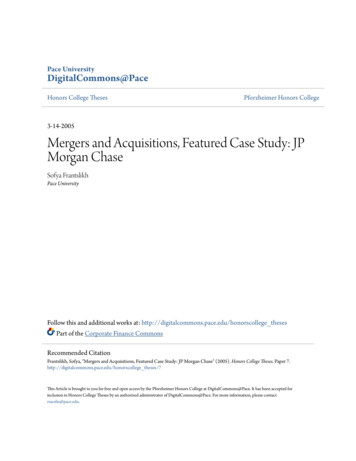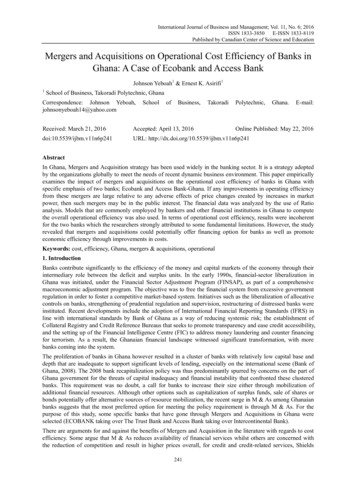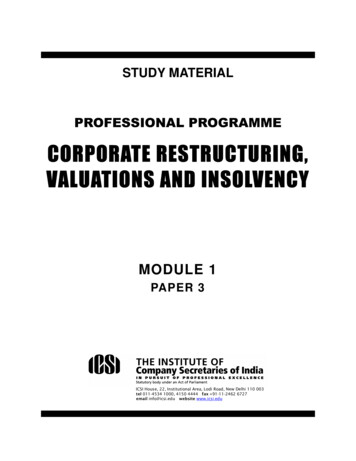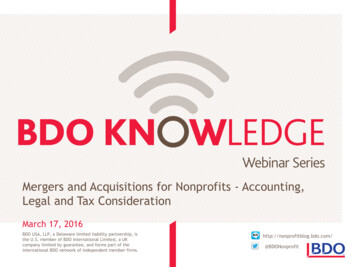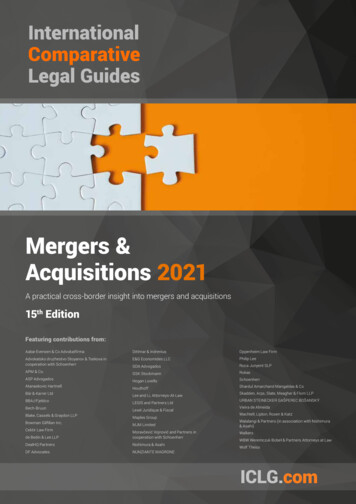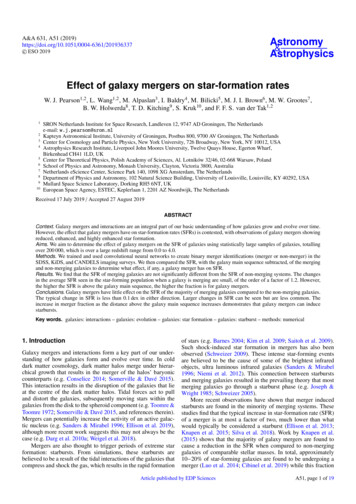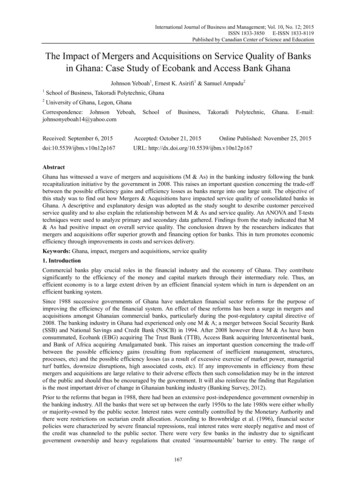
Transcription
International Journal of Business and Management; Vol. 10, No. 12; 2015ISSN 1833-3850E-ISSN 1833-8119Published by Canadian Center of Science and EducationThe Impact of Mergers and Acquisitions on Service Quality of Banksin Ghana: Case Study of Ecobank and Access Bank GhanaJohnson Yeboah1, Ernest K. Asirifi1 & Samuel Ampadu21School of Business, Takoradi Polytechnic, Ghana2University of Ghana, Legon, GhanaCorrespondence: Johnson akoradiPolytechnic,Received: September 6, 2015Accepted: October 21, 2015doi:10.5539/ijbm.v10n12p167URL: ail:Online Published: November 25, 2015AbstractGhana has witnessed a wave of mergers and acquisitions (M & As) in the banking industry following the bankrecapitalization initiative by the government in 2008. This raises an important question concerning the trade-offbetween the possible efficiency gains and efficiency losses as banks merge into one large unit. The objective ofthis study was to find out how Mergers & Acquisitions have impacted service quality of consolidated banks inGhana. A descriptive and explanatory design was adopted as the study sought to describe customer perceivedservice quality and to also explain the relationship between M & As and service quality. An ANOVA and T-teststechniques were used to analyze primary and secondary data gathered. Findings from the study indicated that M& As had positive impact on overall service quality. The conclusion drawn by the researchers indicates thatmergers and acquisitions offer superior growth and financing option for banks. This in turn promotes economicefficiency through improvements in costs and services delivery.Keywords: Ghana, impact, mergers and acquisitions, service quality1. IntroductionCommercial banks play crucial roles in the financial industry and the economy of Ghana. They contributesignificantly to the efficiency of the money and capital markets through their intermediary role. Thus, anefficient economy is to a large extent driven by an efficient financial system which in turn is dependent on anefficient banking system.Since 1988 successive governments of Ghana have undertaken financial sector reforms for the purpose ofimproving the efficiency of the financial system. An effect of these reforms has been a surge in mergers andacquisitions amongst Ghanaian commercial banks, particularly during the post-regulatory capital directive of2008. The banking industry in Ghana had experienced only one M & A; a merger between Social Security Bank(SSB) and National Savings and Credit Bank (NSCB) in 1994. After 2008 however three M & As have beenconsummated, Ecobank (EBG) acquiring The Trust Bank (TTB), Access Bank acquiring Intercontinental bank,and Bank of Africa acquiring Amalgamated bank. This raises an important question concerning the trade-offbetween the possible efficiency gains (resulting from replacement of inefficient management, structures,processes, etc) and the possible efficiency losses (as a result of excessive exercise of market power, managerialturf battles, downsize disruptions, high associated costs, etc). If any improvements in efficiency from thesemergers and acquisitions are large relative to their adverse effects then such consolidation may be in the interestof the public and should thus be encouraged by the government. It will also reinforce the finding that Regulationis the most important driver of change in Ghanaian banking industry (Banking Survey, 2012).Prior to the reforms that began in 1988, there had been an extensive post-independence government ownership inthe banking industry. All the banks that were set up between the early 1950s to the late 1980s were either whollyor majority-owned by the public sector. Interest rates were centrally controlled by the Monetary Authority andthere were restrictions on sectarian credit allocation. According to Brownbridge et al. (1996), financial sectorpolicies were characterized by severe financial repressions, real interest rates were steeply negative and most ofthe credit was channeled to the public sector. There were very few banks in the industry due to significantgovernment ownership and heavy regulations that created ‘insurmountable’ barrier to entry. The range of167
www.ccsenet.org/ijbmInternational Journal of Business and ManagementVol. 10, No. 12; 2015financial products was narrow and industry competition was low Brownbridge et al., (1996). The result was onover regulated, unattractive and inefficient banking system which did not promote economic growth. Theresearchers therefore, sort to identify how Mergers and Acquisitions have impacted service quality in theBanking industry in Ghana.1.1 Statement of ProblemExisting literature on bank efficiency in Ghana predominantly adopts financial indicators such as cost or profitefficiency. Non-financial factors which are said to offer a good guide; Umar and Olatunde (2011), particularly,when adopted in conjunction with financial indicators, can provide superior outcome.This paper attempts to contribute to bridging this perceived gap by assessing the improvement or otherwise inservice quality of selected Ghanaian Banks following M & A.1.2 Research QuestionsIn order to gather and analyze relevant data, the following research questions were formulated to guide the study Are the banks in Ghana meeting the services quality needs of their customers after Mergers andAcquisitions? To what extent have the banks met the expectation of customers after M&A? What are the perceptions of customers on service quality of the banks before and after Mergers andAcquisitions?1.3 Research ObjectivesThe general objective of the study is to explore and establish the essence of Mergers and Acquisitions and itsimpact on service quality among the banks in Ghana. The specific objectives of the study are therefore to: Ascertain if the banks in Ghana are meeting the services quality needs of their customers after Mergers andAcquisitions. To evaluate the extent to which the banks have met the expectation of customers after M & A. To examine the perception of customers on quality of service of the banks before and after Mergers andAcquisitions.2.0 Literature ReviewThe chapter covers the literature reviewed on concepts, theories and types pertaining to mergers and acquisitionsand service quality.2.1 Conceptual DefinitionsMerger and Acquisition literature is laden with usage of terms like merger, acquisition, takeover andamalgamation. Many authors classify them differently. A few arduously distinguish between each, whereasothers use them synonymously. For example, (Weston, Chung, & Hoag, 1996) recognize two forms ofcombinations- mergers and acquisitions (tender offers). Machiraju (2003) on the other hand uses merger as abroader term and considers acquisitions and takeovers as two of its type. Other works in the area classifycombinations as mergers, acquisitions (takeovers) and hostile takeovers (tender offers are considered as one ofthe modus operandi for hostile takeovers.According to Machiraju (2003, p. 1), ‘merger is a broad term and it denotes the combination of two or morecompanies in such a way that only one survives while the other is dissolved. A merger is an investment in afuture growth opportunity. In merger proposals plant is ready and market acceptance, clear and well established.When two companies differ significantly in size, they usually merge’. Weston, Chung and Hoag (1996, p. 4)define merger as, ‘any transaction that forms one economic unit from two or more previous ones’. Mc Carthy(1963, p. 16) defines merger as, ‘the combination of two or more business entities into a single economicenterprise.2.2 AcquisitionsAcquisitions involve one company buying over all or a majority of the assets of another company Okonkwo,(2004). Acquisitions therefore put decision making authority into the hands of the acquiring company. Okonkwo(2004) explains that consolidation through acquisition means that the shareholders of the purchased firm are paidoff, their ownership rights over assets and they cease to be owners of the new entity.Acquisitions can result in two main outcomes: whether the acquired institutions are consolidated into one single168
www.ccsenet.org/ijbmInternational Journal of Business and ManagementVol. 10, No. 12; 2015institution or continue to operate as separate entities under new ownership (Pilloff & Santomero, 1996). Theundertaking of mergers result in the sharing of assets wherein the shareholders of both joining companies stillretain some level of ownership in the new. Acquisitions on the other hand result in a complete change or handingover in the ownership structure of the new entity Okonkwo (2004).According to Machiraju (2003, p. 2), ‘the traditional acquisition is the negotiated acquisition in which a willingbuyer and willing seller negotiate the terms under which an acquisition or merger occurs. Acquisition refers to asituation where one firm acquires another and the latter ceases to exist. A firm that attempts to acquire or mergewith another company is called an acquiring company. A target company is a firm that is being solicited by theacquiring company. The assets of the dissolved firm would be owned by the acquiring company. Theshareholders of the acquired company are paid either cash or given shares in acquiring company’. Mc Carthy(1963, p. 16) defines acquisition as, ‘a number of so-called mergers involving exchanges of capital stocks legallyare acquisitions, particularly where there are large number of shareholders involved. In such non-merger cases,one company “acquires” the voting stock of another solely in exchange of its voting stock. Acquisitions, in alegal sense, may also be effected for cash or cash equivalent, such as debt securities’. According to De Pamphilis(2001, p. 5), ‘an acquisition occurs when one company takes a controlling stake in another firm, a legalsubsidiary of another firm, or selected assets of another firm such as a manufacturing facility’.2.3 Theories of Mergers and AcquisitionsMergers and acquisitions is an aspect of corporate strategy and corporate finance that deals with the integrationof different companies and similar entities that can help an enterprise grow rapidly in its sector or location oforigin, or a new field or new location, without creating a subsidiary or using a joint venture Gaughan (2007).Economists have promoted several competing theories of M&As. Among them are empire-building (Baumol,1967; Mueller, 1969), furthering anticompetitive activities, such as monopoly power (Roll, 1986; Mueller, 1993),management-entrenchment (Shleifer & Vishny, 1989), and an overestimation of a manager’s ability to improvethe performance of a target he or she perceives to be underperforming (Roll, 1986).The two leading M & A efficiency theories are the disciplinary and synergistic merger motives: Disciplinarymergers theory suggests that M & As discipline target firms’ managers who pursue objectives other than profitmaximization. Managers who do not maximize profits presumably would focus attention on goals other thanprofitability. Since this difference in focus can come at the expense of operating efficiency, a firm’s performancemay suffer. Poor performance does not go unnoticed, however. Opportunistic buyers may observe the poorperformance accompanied by good assets and discipline the poorly performing plant by acquiring it. Thus, thedisciplinary theory suggests that acquiring firms merge with poorly performing targets and improve theirperformance as new management realizes the full potential of a target’s assets.Synergistic mergers theory holds that firm managers achieve efficiency gains by combining an efficient targetwith their business and then improving the target’s performance. Buyers recognize specific complementaritiesbetween their business and that of the target. Thus, even though the target is already performing well, it shouldperform even better when it is combined with its complementary counterpart, the buyer firm. The synergistictheory implies that target firms (or plants) perform well both before and after mergers.2.4 Types of MergersAlthough merger and consolidation have been used interchangeably, there is a distinction between the two terms.According to Gaughan (2002) “A merger is a combination of two corporations in which only one corporationsurvives and the merged corporation goes out of existence. In a merger, the acquiring company assumes theassets and liabilities of the merged company. A merger differs from a consolidation, which is a businesscombination whereby two or more companies join to form an entirely new company. All of the combiningcompanies are dissolved and only the new entity continues to operate”. Lepetit et al. (2004) differentiatedbetween merger and acquisition; they defined merger as a transaction when firm (A) (or entity) is merged withfirm (B), subsequently the legal existence of one (at least) original entity is seized to exist. An acquisition, on theother hand, is considered to be a transaction where one firm purchases a dominant stake of another firm withoutcombining the assets of the firms involved.According to Weston and Weaver (2004), from economic perspective, mergers can be categorized based onoccurrence of merger at different level of the firm’s operation whether it starts its economic operation,manufacturing or production, distribution (wholesale or retail) ending with the final consumers. The three broadtypes of mergers are vertical mergers, horizontal mergers and conglomerate mergers.Weaver (2004) explained the three broad types as follows:169
www.ccsenet.org/ijbmInternational Journal of Business and ManagementVol. 10, No. 12; 2015Vertical mergers take place between firms at “different stages of production”. This is more obvious when themerging firm’s business operations involve relationship between buyer and seller. In contrast to vertical mergers,horizontal mergers entail firms (two or more) that operate and compete in the same type of product operations.Advocates of this type of merger claim that horizontal mergers realize economies of scale. A vital issueassociated with horizontal mergers is market concentration where number of firms is reduced which could leadto monopoly power.Finally, conglomerate mergers occur when the combining firms operate in different unrelated industries. That is,there is no "buyer-seller relationship" between firms engaged in the merger. There are two ways in which theacquirer may take over the target firm; either through statutory merger or purchase of assets. Under the statutorymerger, the acquiring firm takes statutorily over the target firm where the shares of the latter are exchanged forthe shares of the buying firm, followed by the legal dissolution of the target company. In purchase of assetsmethod, the acquiring firm might purchase the assets and become legally responsible for the liabilities of thetarget firm.2.5 The Concept of Service QualityService quality has been defined in the literature as a measure of the perceived value customers place on servicesreceived (Cunningham & Young, 2002). Customers are said to compare service perception to service expectationswhen judging the quality of a service offered by a firm. In today’s competitive banking environment deliveringservice of superior quality serves as key for success (Samli & Frohlich, 1992).Service quality has been linked with customer satisfaction within the banking industry (e.g. Avkiran, 1994;Blanchard & Galloway, 1994). Proponents of this theory include researchers such as Yi, (1990); Bloemer, et al(1998); Bastos and Gallego (2008); Chai et al. (2009). Bastos and Gallego (2008) provide evidence that customerservice quality directly affects the positive behavioral intentions. Today’s customers face a growing range ofchoice in the products and services they can buy. Customers will normally choose the offer that maximizes thedelivered value and provide the highest satisfaction. Thus it is of utmost important that companies understand thedeterminants of customer value and satisfaction in order to flourish.Increased customer satisfaction leads to behavioral outcomes such as commitment, intent to stay customerretention, creation of a mutually rewarding relationship (bond) between the service provider and the user,increased customer tolerance for service failures and positive word-of mouth advertising about the organization(Gounaris et al., 2003; Reichheld, 1996; Newman, 2001). Only customer-centered companies that can deliversuperior value to their target customers will win or survive in the market. Those companies will be adept atdeveloping customers, not just developing products. They will be skillful in marketing engineering, not justengineering (Hinson et al., 2006). There is a growing body of theoretical and empirical knowledge on therelationships among customer satisfaction, customer loyalty, and profitability (see Heskett et al., 1994: Nelson etal., 1992; Rust & Zahorik, 1991; Storbacka et al., 1994). An empirical study conducted by Hallowel (1995) thatcustomer satisfaction, customer loyalty, and profitability are related to one another. Thus:Customer satisfaction . customer loyalty . profitability.Hence in the light of the service-profit chain proposed by Heskett et al. (1994) and the empirical work byHallowell (1995), it can be said that it is highly probable for a firm (bank) that provide superior services to win thelifetime loyalty of their customers and improve profitability through growth in customer base and market share.2.6 Measuring Service QualityThe measurement of service quality is traditionally based on the concept of perception – expectation gap analysisGronroos, (1994). Expectations are viewed as desires or wants of customers; i.e. what they feel a service provider‘should’ offer rather than ‘would’ offer (Parasuraman et al., 1988). Service in this sense comprises a complexbundle of explicit and implicit attributes. The array of service quality models in the literature stem from thedisagreements in the nature and contents of service quality dimensions Suuroja (2003). For example Gronroos(1984) divided customer perception of service process into two dimensions; Technical quality – what customers get. Functional quality – how customers get what they get.Lethinen and Lehtinen (1991) also proposed a three dimensional view of service quality as follows: Physical quality-physical environment. Interactive quality – provider interaction/customer participation fit.170
www.ccsenet.org/ijbm International Journal of Business and ManagementVol. 10, No. 12; 2015Corporate quality – corporate image.Parasuraman et al. (1988) proposed a more specific tool of service quality dimensions. According to them theoverall evaluation of service quality derives from the evaluation along five dimensions;* reliability – ability toperform the promised service dependably and accurately.Assurance – Knowledge and courtesy of employees and their ability to inspire trust and confidence.Tangibles – physical facilities, equipments and appearance of personnel.Responsiveness – willingness to help customers and provide prompt service.Empathy – caring, individualized attention that the firm provides to its customers.Service quality is an average of the expectancy – performance gap along these five dimensions.Nyeck et al. (2002) reviewed 40 articles that made use of the SERVQUAL measuring tool and concluded thatalthough the tool has its criticisms it remains the most complete attempt to conceptualize and measure servicequality.3. MethodologyThis chapter presents the methodology of the study. It covers the research design, population, samplingtechniques, data collection procedures and data analysis.3.1 Research DesignThe study is both a descriptive and explanatory in purpose as it seeks to describe customer perceived servicequality and also explain the relationship between service quality and efficiency as banks in Ghana expand theiroperations through mergers and acquisitions.3.2 The Choice of BankThe objective of the study is to assess how M & A has impacted service quality of selected commercial banks inGhana, particularly following the 2008 bank recapitalization. This presupposes that the data for the study shouldcover both pre and post M & A periods, preferably starting from 2008. The two banks selected, Ecobank andAccess Bank are two of the first banks to undergo consolidation after the 2008 bank recapitalization policy. Whatmakes them more important for this research is the fact that unlike Bank of Africa, these two banks were inoperation as of 2008. However, Bank of Africa commenced operation in Ghana in 2011, same year as when itcombined operations with Amalgamated Bank of Ghana.3.3 Population and Sample SizeThe population for the study was individual customers of the selected Banks (Ecobank and Access Bank) locatedin the Greater Accra Region. Customers of commercial banks include all of the various categories of customersof the banking industry. This makes the selected banks unique case for our study. The population is acomposition of individuals of varied background characteristics in terms of sex, ages, level of education andprofession. A total sample size of 80 customers was selected for the study.3.4 Sampling Technique Different Bank branches in Accra for each bank were used for sampling to minimize location bias. Also customers who had been with their respective banks for at least 4 years as of the time of the surveywere targeted. This is because the M & A exercise for the banks under study occurred between 2011 and early2012 and such customers will be in a better position to provide more reliable data.3.5 Data Measuring InstrumentThe SERVQUAL model of Kumar, Kee and Manshor (2009) for measuring service quality in banks, based onfour dimensions; Tangibility, Reliability, Responsiveness and Convenience, was adopted for this study. Theoriginal SERVQUAL model Paarasuraman et al. (1991) measures service quality along the lines of empathy,reliability, responsiveness, tangibility and assurance. A fifth dimension, ‘range of products/services’, assuggested by Hinson et al (2006) in the context of bank services was included. Convenience and product/servicesrange are two important factors that in our view cannot be overlooked in the context of merging banks. Bankconsolidations will invariably result in additional branches and broader spectrum of product/services which canpotentially impact on customers perceived service quality.The original instruments were fourteen (14). However, for the pre and post - merger service quality assessmentour data collection instruments consisted of twenty eight (28) items.171
www.ccsenet.org/ijbmInternational Journal of Business and ManagementVol. 10, No. 12; 2015For each dimension customers are required to indicate their expectation (E) and perception (P) on a five (5)points likert scale. Expectation-Perception gap scores are computed and analysed to assess service quality. Thus,based on the expectancy-disconfirmation paradigm, if E P, the customer is dissatisfied and if E P thecustomer is satisfied Parasuraman et al. (1991a).3.6 Indicators of overall Service QualityIn this study, overall service quality is conceptualized to be dependent on the dimensions of service quality and isan average of the gap scores of the dimensions. Hence, overall service quality is computed as follows:Gap ScoresPost M & APre M & AAverage Convenience gap score/3/3Average Product/Service range gap score/3/3Average Tangible gap score/2/2Average Reliability gap score/3/3Average Competence gap score/3/3TOTAL/3/3AVERAGE ( Total /5) UNWEIGHTED SERVQUAL SCORETotal 5Total/53.7 Data Gathering TechniqueService quality data in the form of primary data was collected by means of questionnaire, using SERVQUALmodel (Parasuraman et al., 1988) as a guide. The questionnaire consisted of three parts; A (customer profile),Part B (customer banking profile) and Part C (45 items on customer expectations and perceptions of servicequality before and after merger). A total of 80 questionnaires were administered; 40 to Ecobank customers, 40 toAccess Bank customers.4. Data AnalysisThe study employed quantitative data analysis. ANOVA (analysis of variance) and T-test (one tail) techniqueswere used. For each service quality dimension, ANOVA was used to test the differences among means for pre acquisition perception, post - acquisition perception and expectation. The T-test was used to further probe thesignificance of the pre - acquisition gap (i.e. pre-acquisition perception verses expectation) and post - acquisitiongap (i.e. post - acquisition perception and expectation) for each service quality dimension.This chapter deals with the analysis, interpretation and presentation of both primary and secondary data collected.It begins with primary data analysis followed by secondary data analysis.The primary data analysis includes profile of respondents (gender, age, and educational level), the perception andexpectation gaps of service quality dimensions and overall service quality. The foregoing analyses are done onpre-acquisition and post-acquisition data of the two banks under consideration; Ecobank Ghana and Access Bankof Ghana. Results thereof are presented in tabular forms.Statistical tools employed in the primary data analysis are Anova (single factor) analysis and t-Test) Paired TwoSamples for Mean). Anova allowed for significance testing between and within Means of more than twoobservations. For example for each service quality dimensions (say convenience) it is possible to testsignificance of Mean differences for pre-acquisition service perception, post-acquisition service perception andservice expectations. Whereas the Anova gives us a general result of pre-and post - acquisition service level forconvenience, the t-Test is able to tell us whether pre-acquisition convenience was better than post - acquisitionconvenience or otherwise.4.1 Profile of RespondentsTo help achieve the set objectives of the study, data was collected on the background characteristics of therespondents. This data is summarized in Table 4.1 below.172
www.ccsenet.org/ijbmInternational Journal of Business and ManagementVol. 10, No. 12; 2015Table 1. Background information of respondentsDESCRIPTION CATEGORYECOBANKACCESSFREQFREQ% FREQ% 0100.040100AgeBelow 20 91127.51025.050-59615.037.560 and e1025.0922.5Total40100.040100.0EducationSource: Field Survey, (2015).Table 1 shows that 23 out of 40 (representing 57%) Ecobank respondents were male and 17 (i.e. 42.5%) werefemale. Gender distributions for Access Bank respondents followed similar trend; 21 out of 40 (i.e. 52.5%) weremale and 19 (representing 47.5%) were female. Statistical analysis shows a strong positive correlation ( 1)between gender distributions of the two banks.Table 1 also indicates that 37 out of 40 Ecobank respondents (representing 92.5%) were within the working classage group (20-59years) and the remaining 7.5% were either between 20years or above 60years. Similarly, 38 outof 40 (representing 95%) respondents of Access Bank were within the working class age group. The remaining 5%were over 60years. This follows a simple logic that the active and working population of Ghana is expected toconstitute the largest group of Bank customers.Another indication of Table 1 is that 27 out of 40 Ecobank respondents (representing 68%) and 29 out of 40Access Bank respondents (representing 72.5%) were highly educated (graduates or post-graduates). This is areflection of the demographics of the local residents where the sampling was conducted.4.2 Anova and T-tests for Service Quality DimensionsTable 2. Anova and t-tests for convenience (Ecobank)ConvenienceMeanCountStd. est (one 85397.5791.68539Source: Field Survey, (2015).Table 2 above shows the analysis of Means for pre and post - acquisition perception verses expectation of servicequality with regards to convenience at Ecobank. Single factor analysis of variance between and within scoresrevealed a significant difference among the three Means. Paired sample t-test for Means further revealedsignificant pre- acquisition gap for convenience (i.e. difference between pre-acquisition perception andexpectation) of -0.9 (2.400-3.300) and a significant post-acquisition gap (difference between post- acquisitionperception of 1.125 (4.425-3.300). The negative pre- acquisition gap indicates that Ecobank customers’173
www.ccsenet.org/ijbmInternational Journal of Business and ManagementVol. 10, No. 12; 2015perception of service quality with regards to convenience fall short of their expectation. The positive postacquisition convenience gap however indicates that after the M & A exercise Ecobank is meeting the bankingneeds of the customers as far as convenience is concerned.Table 3. Anova and t-tests for convenience (Access Bank)ConvenienceMeanCountStd. DExpectation3.37540Perception – Pre2.325400.944Perception – Post4.450400.552Anova (single-factor)t-test (one ritDf0.77475.4253.074Source: Field Survey (2015).Table 3 above shows the analysis of means for pre- and post - acquisition perception verses expectation ofservice quality with regard to convenience at Access Bank. As it was in the case of Ecobank, single factoranalysis of variance between and within scores revealed a significant difference among the three Means. Pairedsample t-test for Means further revealed a significant pre-acquisition gap
2008. The banking industry in Ghana had experienced only one M & A; a merger between Social Security Bank (SSB) and National Savings and Credit Bank (NSCB) in 1994. After 2008 however three M & As have been consummated, Ecobank (EBG) acquiring The Trust Bank (TTB), Access Bank acquiring Intercontinental bank,


